This miso kimchi ramen has an impossibly umami, bright and spicy flavor profile. Topped with bean sprouts, sweet corn – and a toasted garlic and scallion oil – this Korean influenced Japanese noodle soup is proof that you can enjoy restaurant quality ramen at home. Ready in 30 minutes from start to finish!
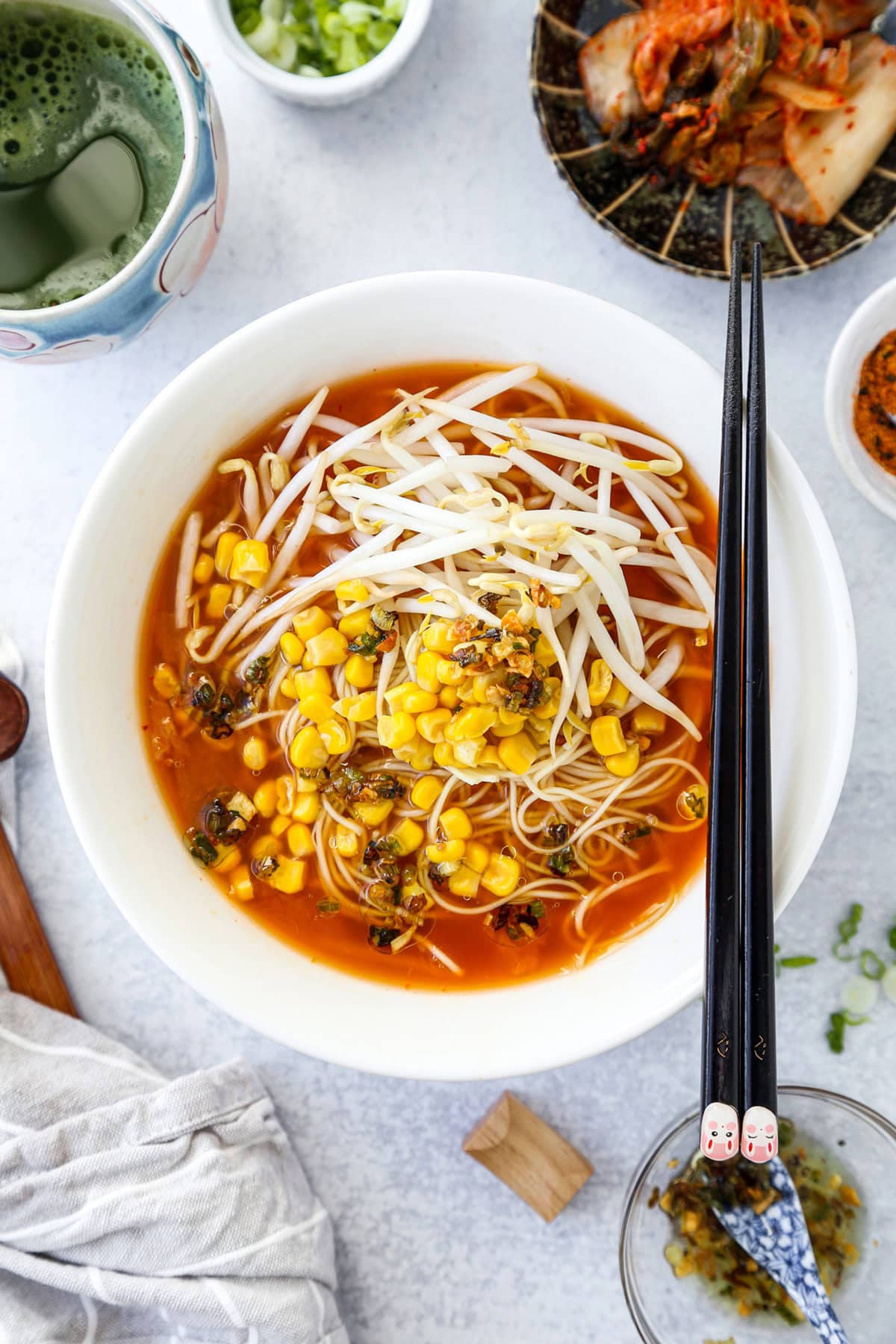
A Flavor Packed Miso Kimchi Ramen Recipe
Have you ever found yourself wondering how to make ramen better?
Obviously, ramen is already a great thing. But, in my opinion, one possible answer to that question is creating a broth loaded with kimchi and miso.
This miso kimchi ramen recipe has the smokiness and umami of miso, the bright pungent funk from kimchi – rounded out with a dash of toasted garlic and scallion oil. Topped with corn and fresh bean sprouts, this Japanese / Korean mash-up is a real winner!
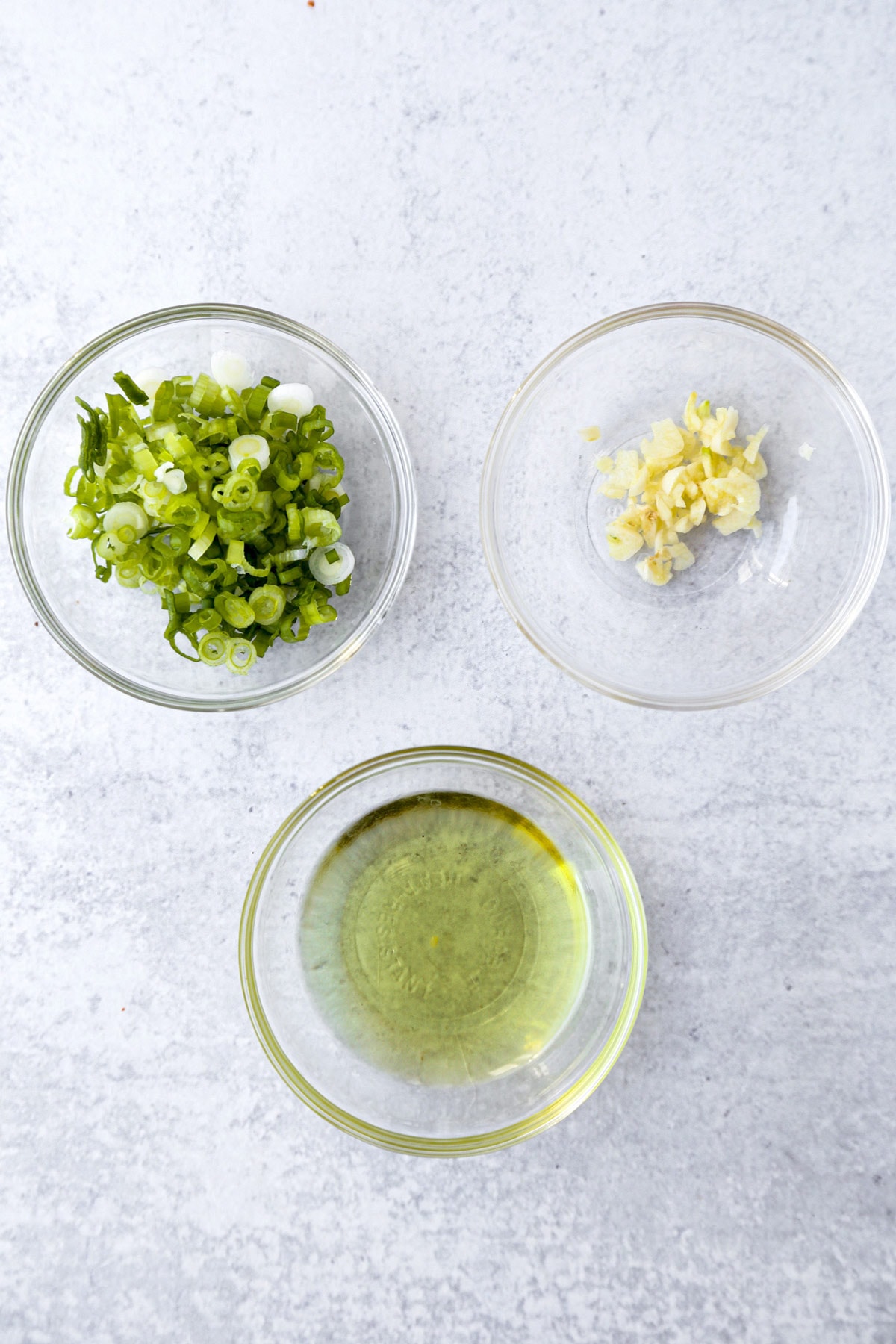
Miso Kimchi Ramen Ingredients
Scroll all the way down for the full recipe.
- Garlic, Scallions and Vegetable Oil: You’ll use these ingredients to make a simple yet magnificent infused oil to drizzle over your ramen. Best part: the caramelized garlic bits!
- Vegetable Broth or Chicken Broth: You can use either as a soup base. However, since the flavors in this kimchi ramen recipe are quite assertive, I’d recommend using low-sodium broth as your starter.
- Miso Paste: This fermented paste brings a savory, umami and earthy funk to the soup base. Use white miso or awase miso (which is a mixture of red and white miso) for the best results. More on miso in a sec.
- Oyster Sauce: Assertive savory, marine notes meld with a mildly sweet undertone. This stuff is magic! Omit this ingredient if you’re making vegan ramen. Grab oyster sauce here on Amazon.
- Gochugaru: This is Korean red pepper powder. And while typically not volcanic, there’s some great smokey heat there.
- Kimchi: Funky, pungent, and a little spicy! You’ll want both the fermented cabbage and the kimchi juice for this recipe. We’ll also take a closer look at kimchi below.
- Ramen Noodles: You can use fresh noodles, or dry. A dry ramen packet (separated from the packet of soup powder) even works. Be sure to read the package instructions before boiling to make sure you don’t overcook your noodles. And remember, fresh ramen noodles cook FAST!
- Bean Sprouts: Bean sprouts deliver a fresh, crisp texture – and, as they slightly cook in the hot soup, soak up the savory broth. Aside from fresh green onions and nori, bean sprouts are my favorite ramen topping!
- Corn: It’s the perfect compliment to the pungent kimchi. Corn brings fresh pops of natural sweetness and yet another textural element.
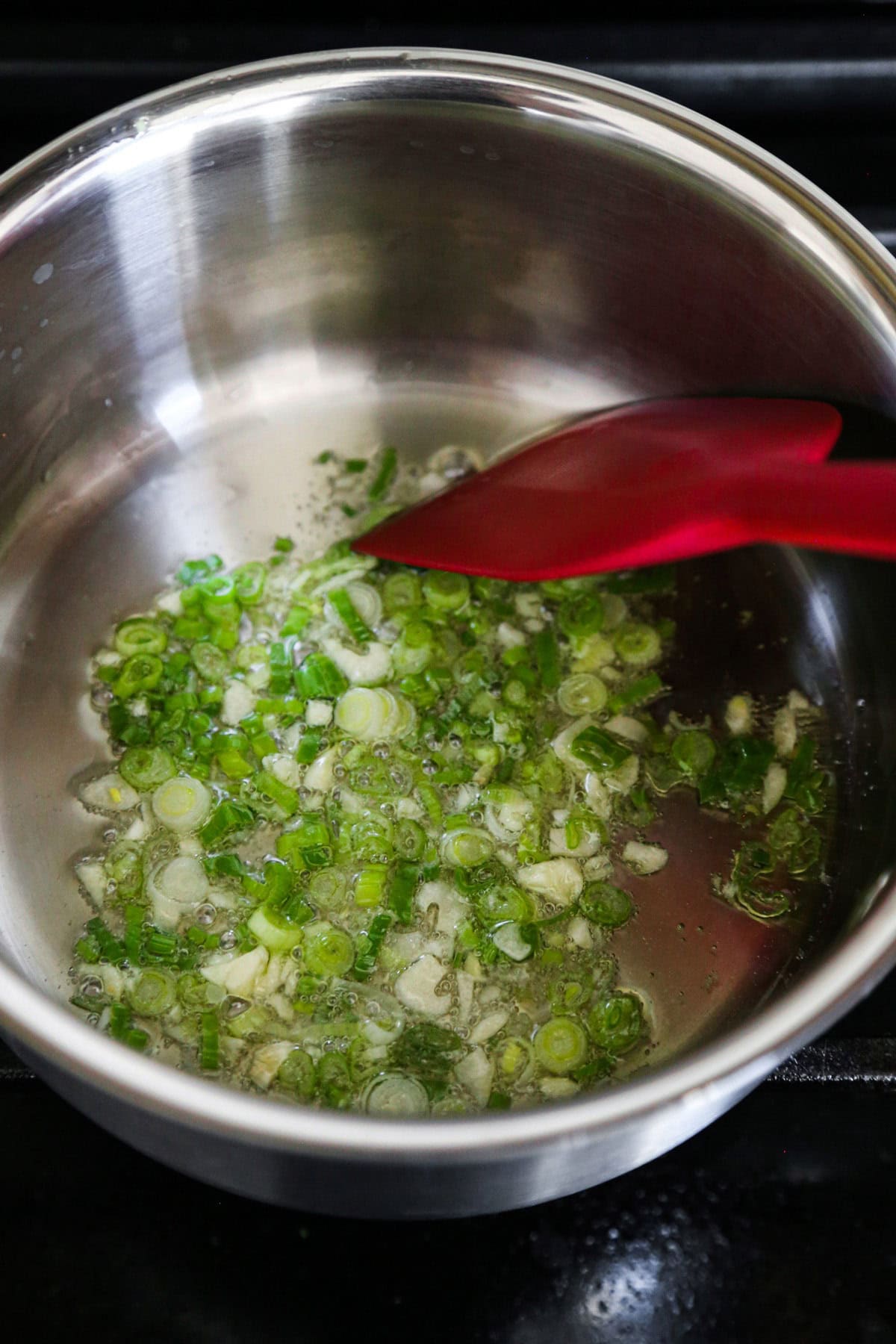
What is Miso?
Miso (味噌) is a Japanese fermented soybean paste.
It is produced by mixing soybeans with a rice (or barley) based koji starter. As that mixture ferments it produces a a salty, earthy, funky and umami flavor.
Miso is not only the flavor base in miso soup – this fermented food is also used when making Japanese pickles, salad dressings and izakaya favorites like nasu dengaku.
For a much deeper dive on Japanese miso paste, check out this post.
There are many miso variants. Typically, white miso is the mildest, and red miso is the strongest. For this miso kimchi ramen recipe, I’m using awase miso: a mixture of red and white miso with a balanced flavor profile.

What is Kimchi?
Kimchi (김치) is Korean salted, spiced and fermented vegetables.
While napa cabbage is the most well known kimchi ingredient, there are a ton of variants. Cucumber, scallions, daikon radish and burdock root are just a few.
While many kimchi variants include fish sauce or anchovy, I have a recipe you can use to make an easy vegan kimchi at home!
- What Does Kimchi Taste Like? The flavors in kimchi are varied – and it’s not uncommon to notice tasting notes from bright and sour to spicy to sweet to funky and umami. However, no matter how sour a kimchi variation is, it’s not the sourness you might get from vinegar (think of a pungent sauerkraut and you’re almost there). Much of the overall flavor will also depend on which veggies were used in the recipe.
- Is Kimchi Spicy? While spice is typically an element in kimchi, there are variations that range from comparatively mild to volcanic. Much of that depends on how much gochugaru (Korean red chili pepper powder) is used during the fermentation process.
Like most fermented foods, kimchi is loaded with probiotics – and it’s the perfect ingredient for this addictive miso kimchi ramen recipe.

How to make Kimchi Ramen
For the Garlic Scallion Oil
- Gather all of your kitchen tools and ingredients.
- Place the oil, minced garlic and chopped scallions in a small saucepan and turn the burner heat on low.
- Stir the mixture constantly – and cook until the scallions and garlic change to a golden color. This takes about 5 mins. Turn the heat off, transfer the oil to a bowl and set aside.
For the Kimchi Ramen
- In a medium sized pot over medium-high heat, add the broth, miso paste, oyster sauce, gochugaru and kimchi. Mix well and bring to a boil.
- Once boiling, lower the heat to a simmer, cover and cook for another 10 minutes.
- In the meantime, bring a separate pot of water to boil. Boil your ramen noodles according to the directions on the actual product packaging. Keep in mind that prep time varies wildly. Fresh ramen can be ready in as little as a minute. Most dry ramen takes around 3 mins. Since the noodles will eventually be placed in hot soup (where they will continue to cook), you may want to pull them just a little early.
- Drain the cooked noodles and divide them into serving bowls. Ladle the kimchi soup over the noodles and top with your bean sprouts and corn. Drizzle a bit of the garlic scallion oil over the kimchi ramen and serve immediately.
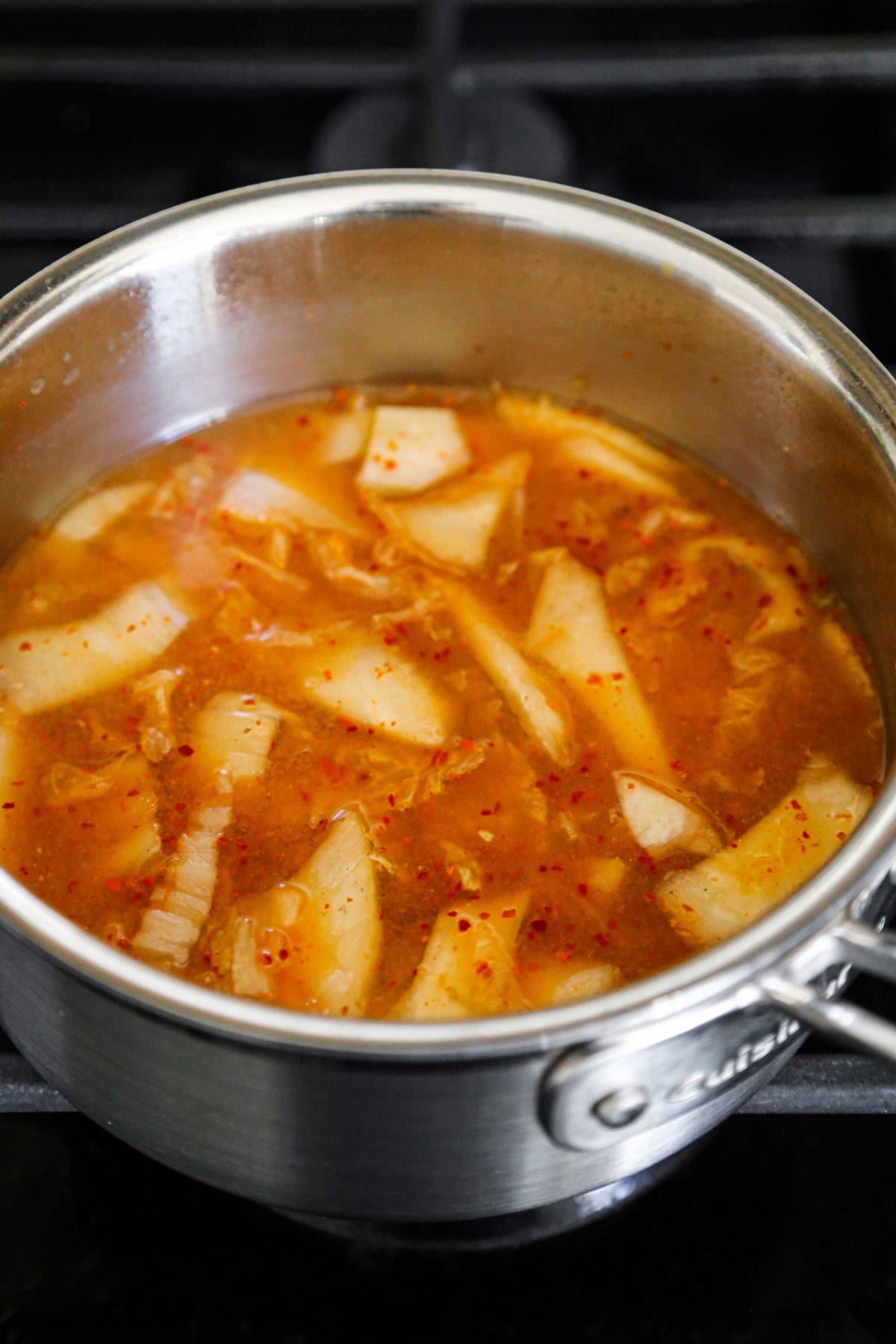
Miso Kimchi Ramen Flavor
So what does it taste like?
While there are intense flavors in this spicy miso ramen, there’s also a real balance and harmony in the bowl. The kimchi is the most assertive and flavor-forward ingredient, and you’ll get bright, sour and savory notes throughout your meal.
The kimchi, however, is tempered and complimented by the earthy funk from the awase miso. Miso has so much umami that it highlights the natural umami notes from the kimchi (without dulling the spice).
And there are deep almost roasted flavors from the caramelized garlic bits in the scallion oil.
This kimchi ramen is savory and spicy – earthy and bright – and texturally varied. I think you’re going to love it!

What to Serve With Kimchi Ramen
The very first place my mind goes when any type of ramen is being served is a side of dumplings. If you’re feeling ambitious, you could try your hand at making your own!
These pan-fried kimchi tofu mandu would compliment this ramen recipe so well.
If you have a package of your favorite Japanese gyoza sitting in the freezer, making one of these easy homemade dumpling sauces will elevate store-bought dumplings to izakaya quality.
Or go the Korean banchan route with a side of scallion loaded pajeon – and this Korean cucumber salad.
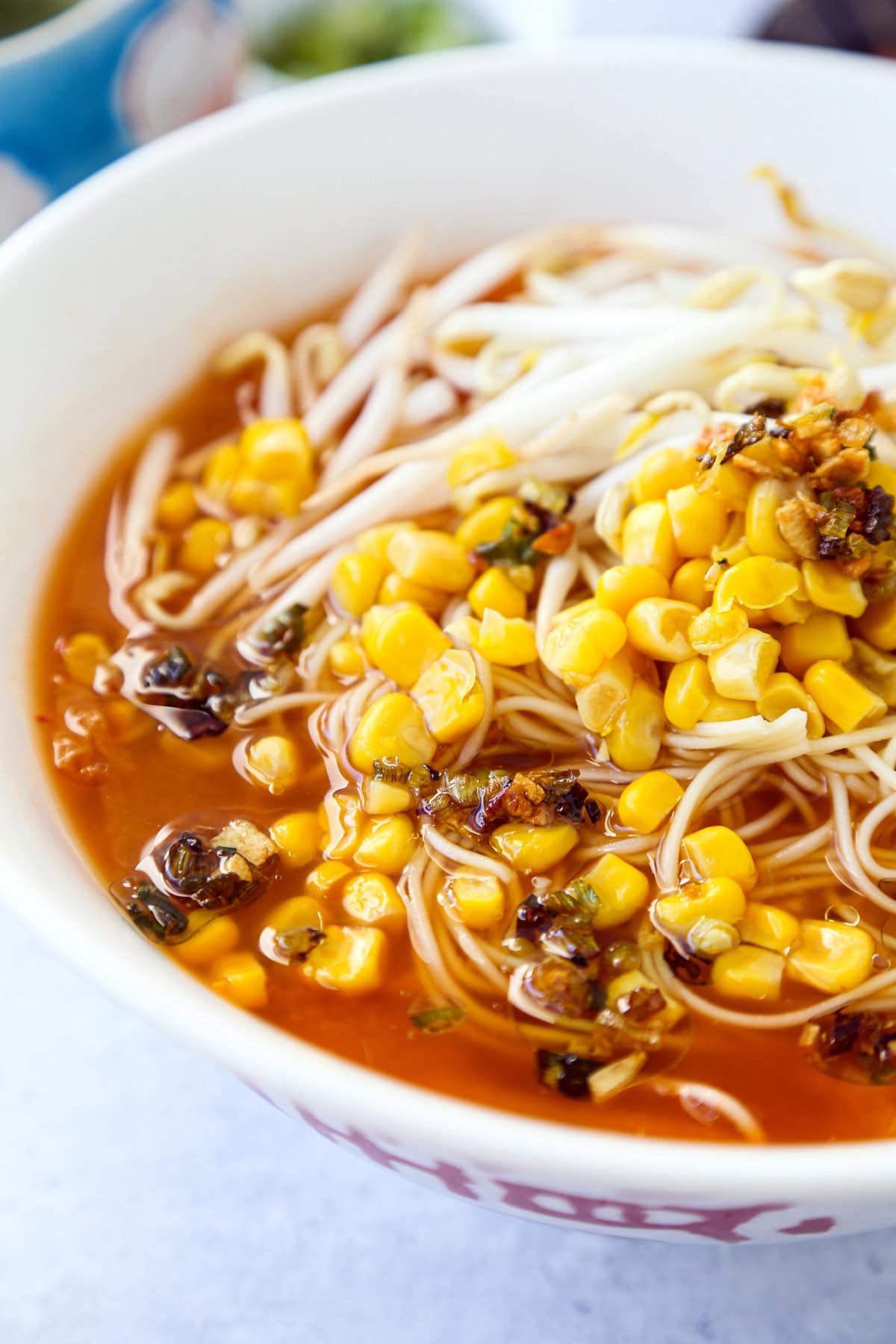
Other Easy Ramen Recipes
When it comes to homemade Japanese noodle soup, having an arsenal of recipes at your fingertips is never a bad thing. There are way more types of ramen than there are days of the week!
Here are a few reader favorites:
- Shoyu Ramen – 醤油ラメーン (Soy Sauce Flavored Ramen)
- Shio Ramen – 塩ラーメン (Salt Flavored Ramen)
- Hiyashi Chuka – Chilled Ramen Salad
- Homemade Miso Ramen – 味噌 ラーメン
- Vegan Ramen
Plus:
Happy cooking!

Did you like this kimchi miso ramen recipe? Are there changes you made that you would like to share? Share your tips and recommendations in the comments section below!
Print
Miso Kimchi Ramen
- Prep Time: 10 minutes
- Cook Time: 20 minutes
- Total Time: 30 minutes
- Yield: 2 bowls 1x
- Category: Soup
- Method: Stove top
- Cuisine: Japanese
- Diet: Vegetarian
Description
Topped with bean sprouts, sweet corn, toasted garlic, and scallion oil – this kimchi ramen is proof that you can enjoy restaurant quality ramen at home.
Ingredients
- 3 tablespoons vegetable oil
- 1 garlic clove, minced
- 2 scallions, chopped
- 4 cups low sodium vegetable broth or low sodium chicken broth
- 2 tablespoons white or awase miso paste (add an additional 1/2 tablespoon for saltier broth)
- 1 tablespoon oyster sauce
- 2 teaspoons gochugaru
- 100g kimchi, chopped with its juices
- 2 packages fresh or dried ramen noodles (6 ounces fresh per bowl, or 3 ounces dry)
- 1 cup bean sprouts
- 1/2 cup canned corn, drained (optional)
Instructions
- Put the oil, garlic, and scallions in a small pot and turn the heat to low. Stir constantly and keep cooking until the scallions change to a golden color, about 5 minutes. Turn the heat off and transfer the oil to a bowl. Set aside.
- In a medium size pot over medium-high heat, add the broth, miso paste, oyster sauce, gochugaru, and kimchi, and bring to a boil.
- Lower the heat to a simmer, cover, and cook for 10 minutes.
- Meanwhile, bring another pot of water to boil.
- When the broth is ready to be served, add your noodles to the boiling water and cook them according to the directions on the package (usually 1 to 3 minutes for fresh ramen noodles).
- Drain the noodles and divide them among two bowls. Pour the kimchi soup over the noodles and top with bean sprouts and corn. Drizzle a little of the garlic scallion oil over the ramen and serve immediately.
Notes
You can make part of the recipe ahead of time by making the flavored oil and kimchi broth. Save them separately and refrigerate the broth until it’s time to use.
Nutrition
- Serving Size: 1 bowl
- Calories: 672
- Sugar: 8.1g
- Sodium: 2997.6mg
- Fat: 25g
- Saturated Fat: 16.8g
- Unsaturated Fat: 2.3g
- Trans Fat: 0g
- Carbohydrates: 99g
- Fiber: 6.8g
- Protein: 17.2g
- Cholesterol: 0mg















This is incredible! I loved it so much. I can’t believe how flavorful the broth was! Definitely will make again and again!
Thank you so much Kat!
my friend gave me some homemade kimchi, so i tried this recipe- i’m a novice cook but this was really easy and soooo delicious. i accidentally added 2 tablespoons of gochugaru instead of teaspoons, but the spice was really good. will definitely make again!
Thank you Justine! 🙂
Everyone in the family from kids to adults devoured the ramen. Only coming up for breaths to exclaim how good it was.
Thank you so much Renee! 🙂